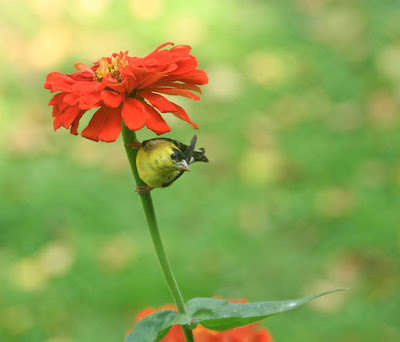It's all in the wingbars. Newly fledged goldfinches (like my patient) have bright wingbars, tinged with cinnamon, and cinnamon-touched edges on their secondary wing feathers. The badly worn adults have lost all the white trim on their secondary coverts (wingbars) and remiges (flight feathers). So in the photo above, from left to right, it goes Mom (no wingbars), Baby 1, Dad (no wingbars), Baby 2.
The Flower Destroyers
Thursday, October 12, 2017
Have your zinnias lost their petals on the bedpost
overnight? Have you been finding puddles of brightly colored sepals and
denuded heads, still gaily ringed with the bright yellow “true flowers” in the
center? I sure have. Experience has taught me who dun it.
You have a guilty look on your face, sir.
Wut. I’m just a goldfinch, perched decoratively on a flower.
I’ll just, ehm, go up in here and do my…thing…
He pulls on the bright red sepal. The seed remains in the flower head. Oops. Ideally, the seed comes out, still attached.
He takes it in his toes, finds it empty of food,
holds it for a precious moment (click!) and lets it drop. The red petal is an exclamation mark on my excitement at capturing him red-billed!
Though the shady north side of my house isn’t perfect for zinnia growing (they’re full sun plants), I couldn’t resist planting one where I could enjoy it from the studio. I’ll draft a zinnia to suffer through the shade every year now, if I can just photograph this scene again!
While we're on goldfinches, you may have noticed that this early autumn male is looking a bit dingy, soiled. His feathers are worn, and the olive feathers of winter are showing through.
Look closely at this photo. Can you tell the parents from their two babies? Two of these things are not like the others. Two of these things are not the same.
It's all in the wingbars. Newly fledged goldfinches (like my patient) have bright wingbars, tinged with cinnamon, and cinnamon-touched edges on their secondary wing feathers. The badly worn adults have lost all the white trim on their secondary coverts (wingbars) and remiges (flight feathers). So in the photo above, from left to right, it goes Mom (no wingbars), Baby 1, Dad (no wingbars), Baby 2.
The incessant peeping of young goldfinches continues in my yard well into October, as these late-breeding birds finally bring off their fledglings. Why, they're peeping today, October 12! Goldfinches are among our latest breeders, waiting for weed seeds to come ripe before building their nests. Even though feeders fill in the gap, the age-old commandments of nature rule their days, pushing breeding into September. When the baby goldfinches finally stop peeping for food, winter is well on its way.
We'll check back in on our injured goldfinch in the next post.
|
Widget for blogger by Way2Blogging | Via Spice Up Your Blog Gadgets
|
Labels:
Am. goldfinch,
goldfinch,
juvenile goldfinch,
zinnia














6 comments:
I learn so much here!
I feel I will know the birds in my much better now. thanks.
Sweet! Mea culpa to the living-in-the-shade zinnia. Ha ha.
Beautiful birds.
And here I thought this might be a “She loves me, she loves me not” scenario!
As beautiful as the photos are, can't you see a gorgeous watercolor in the making?
What beautiful photos! If anyone wonders where the goldfinches go, they are here in Tallahassee Florida right now in February. Their colors are mostly drab, and they are eating at the niger seed feeder. They also help each winter to eat many of the prolific seeds shed from the Chinese elm tree, which reduces their sprouting in all sorts of inappropriate places in the yard.
Post a Comment